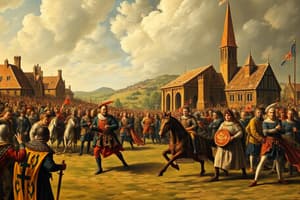Podcast
Questions and Answers
What was one of the main reasons for William's victory at the Battle of Hastings?
What was one of the main reasons for William's victory at the Battle of Hastings?
- Discipline
- Brutality
- Leadership
- Tactics (correct)
Luck was a significant factor in William's victory at the Battle of Hastings.
Luck was a significant factor in William's victory at the Battle of Hastings.
True (A)
Why did Harold Godwinson lose the Battle of Hastings?
Why did Harold Godwinson lose the Battle of Hastings?
Due to tactical errors and being unprepared after the Stamford Bridge battle.
William won the Battle of Hastings by employing a __________ retreat tactic.
William won the Battle of Hastings by employing a __________ retreat tactic.
Match the following concepts with their relevance to the Battle of Hastings:
Match the following concepts with their relevance to the Battle of Hastings:
Flashcards are hidden until you start studying
Study Notes
Key Factors in William's Victory at the Battle of Hastings
- Luck played a significant role; unexpected developments aided the Normans.
- Brutality in combat tactics demoralized the opposing Anglo-Saxon forces.
- Effective leadership from William inspired his troops and maintained morale.
- Motivation among the Norman soldiers driven by the promise of land and power.
- Use of a shield wall by Harold's army provided initial defense but was ultimately breached.
Battle Events and Developments
- The battle occurred on October 14, 1066, after William's march from Normandy.
- Harold Godwinson's forces faced challenges after recent conflicts, particularly Stamford Bridge.
- Normans utilized cavalry, mounted knights, and archers effectively in their assault.
Strategies and Tactics Employed
- Feigned retreat tactic lured Anglo-Saxons into disarray and allowed an effective counterattack.
- Discipline among William’s troops enabled coordinated movements and responses.
- The use of cavalry provided speed and maneuverability, outmatching infantry formations.
Evaluation of William's Victory
- Leadership marked by decisive actions during key moments contributed to his success.
- Tactics, such as the feigned retreat and use of mounted knights, disrupted Harold's strategy.
- Harold’s exhausted forces faced strategic disadvantages after the quick march from Stamford Bridge.
Perspectives on the Battle Outcomes
- Discussion points include identifying errors made by Harold and advantages held by William’s army.
- Evaluation of luck illustrates its role in determining the success of both sides during the battle.
- Harold’s tactical decisions resulted in vulnerabilities that William exploited for victory.
Concluding Thoughts
- The Battle of Hastings marked a turning point in English history with Norman conquest.
- Understanding the factors behind William's success can inform analysis of military leadership and strategy.
Studying That Suits You
Use AI to generate personalized quizzes and flashcards to suit your learning preferences.




